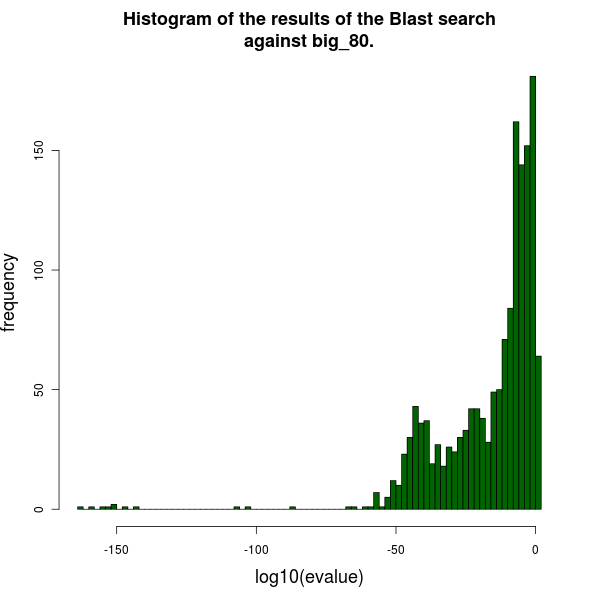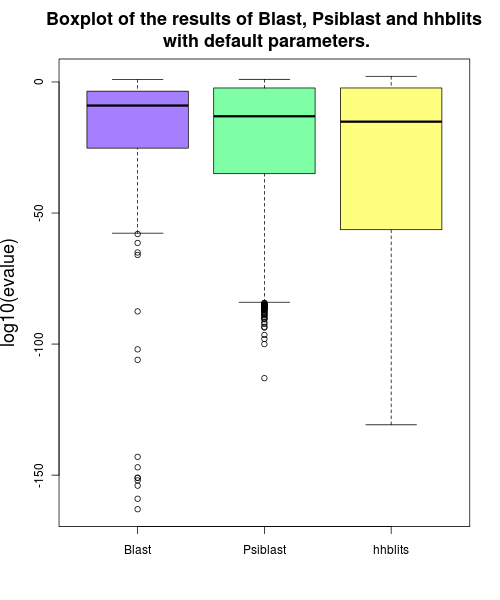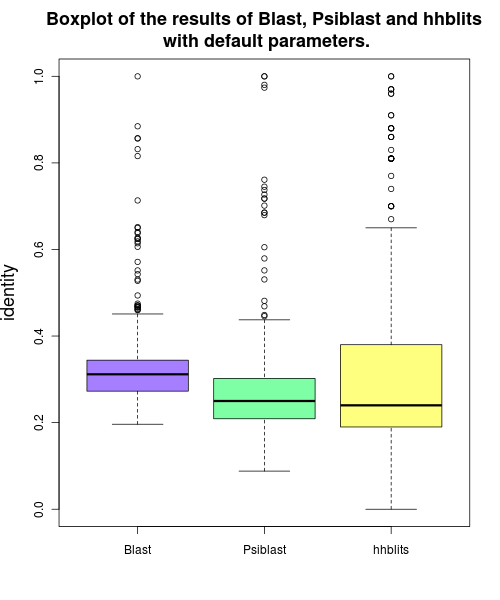Difference between revisions of "Task 2: Alignments"
| Line 168: | Line 168: | ||
| + | [[File:hhblits_hist_e.png|left|frame|Evalue distribution of the results of the HHblits search with default parameters using the using the uniprot20_02Sep11 database. The x-axis shows the natural logarithm of the evalue and the y-axis the frequency. The better the evalue the smaller is log(evalue).]] |
||
| − | [[File:hhblits_hist_e.png|left|frame|TODO evalue]] |
||
| + | [[File:hhblits_hist_i.png|center|frame|Identity distribution of the results of the HHblits search in the uniprot20_02Sep11 database using default parameters. The x-axis shows the relative identity between the query and the hits.]] |
||
| − | [[File:hhblits_hist_i.png|center|frame|TODO idenity]] |
||
| − | |||
| − | |||
| − | |||
| − | TODO: table of hits overlap ? |
||
| + | It is remarkable that HHblits finds so many hits with a very low evalue. This can maybe explained by the fact, that hhblits found several clusters with a good evalue. Since used all proteins in the clusters for the analyses and not only the cluster representative the number of hits is clearly higher than the number of hits from the Blast and Psiblast searches. |
||
| Line 183: | Line 180: | ||
[[File:compDefault_i.png|center|frame|TODO idenity]] |
[[File:compDefault_i.png|center|frame|TODO idenity]] |
||
| + | |||
| + | |||
| + | |||
| + | TODO: Venn diagramms of hits overlap. |
||
| + | |||
Revision as of 16:23, 22 May 2013
Sequence alignments are a good start to analyse a new protein sequence. Alignment search tools such as Blast, Psiblast or hhblits can be used to find related protein sequences.
Contents
Sequence Searches
All searches whre done with an increase number of output lines (10000) in the summary hit list and for the reported alignments in order to have all found hits displayed. The analyses were all conducted using all displayed hits. We set no specific evalue cutoff.
The HFE protein sequence has the Uniprot ID Q30201, NCBI ID 1890180 and PDB ID 1A6Z_A.
All Blast, Psiblast and hhblits output files that where analyses where first parse using the perl script parse_output.pl. For example:
perl /mnt/home/student/kalemanovm/master_practical/Assignment2_Alignments/scripts/task1/parse_output.pl --out_p /mnt/home/student/betza/task2/blast/res_blast.txt
CATH is a database that hierarchically classifies all domain structures from PDB. This hierarchy consists of four major levels: 1. Class 2. Architecture 3. Topology 4. Homologous superfamily
We compared the first level of the CATH hierarchy (Class) to check whether the hits have the same fold class as the query. The class of a domain is determined by its secondary structure composition (mostly alpha, mostly beta, mixed alpha/beta or few secondary structures). Each domain of a protein is assigned to a CATH class, this means, that one query protein can consist of several fold classes, one for each domain. The python script compareCath.py was written to check the overlap of the query protein's fold classes with those of the hits. The two domains of the HFE protein belong to fold class 2 and 3.
Example call:
python /mnt/home/student/betza/scripts/compareCath.py -i /mnt/home/student/betza/task2/blast/res_blast.txt_results -q 1a6zA > /mnt/home/student/betza/task2/blast /res_blast.txt/blast_cath
Another database for protein structure clustering is COPS. It consists of different structural groups that contain all proteins with a structural similarity above athreshold. For example, all proteins in the L30 group have a structural similarity of at least 30% percent. This means that if two proteins are not in the same L30 group, they have less than 30% structural similararity.
The L30 groups of the hits were determined to chek if they are in the same group as HFE or not. This analyses were also done using the script parse_output.pl:
perl /mnt/home/student/kalemanovm/master_practical/Assignment2_Alignments/scripts/task1/parse_output.pl --out_p /mnt/home/student/betza/task2/blast/res_blast.txt --query 1a6z_A --sot L30
Blast
A Blast search in big_80 was executed using the standard parameter settings:
blastall -p blastp -i /mnt/home/student/betza/data/hfe.fasta -d /mnt/project/pracstrucfunc13/data/big/big_80 -o /mnt/home/student/betza/task2/blast/res_blast.txt -v 10000 -b 10000
Blast finds 1504 hits. There are only a few hits with a very high evalue of 1e-160 but most good hits have an evalue between 1e-40 and 1e-50 (left peak). Most results have a worse evalue above 1e-20. Nearly all hits have an identity of 20% to 40% with the query. The evalue and identity distributions are shown below in the plots.
The Blast results only contain 13 PDB IDs. Nevertheless, the number of shared CATH classes betwen HFE and the hits were computed as described above. Of 13 pdb hits, only 3 share all domain fild classes with HFE, 6 have one domain fold class in commom and 4 even none.
| number of same fold classes | frequency |
|---|---|
| 0 | 4 |
| 1 | 6 |
| 2 | 3 |
Only 6 of the 13 pdb hits are in the same COPS L30 group as the HFE protein.
All results indicate, that some of the Blast hits are not really related to HFE and thus false positives.
Psiblast
Four different psiblst runsagaisnt big_80 where done using all four combinaitons of:
- 2 iterations
- 10 iterations
- default E-value cutoff (0.002)
- E-value cutoff 10E-10
Example call for Psiblast with 10 iterations and evalue cutoff of 10E-10:
blastpgp -i /mnt/home/student/betza/data/hfe.fasta -d /mnt/project/pracstrucfunc13/data/big/big_80 -j 10 -h 10E-10 -v 10000 -b 10000 -o /mnt/home/student/betza /task2/psiblast/new/j1h1/j1hi.txt -Q /mnt/home/student/betza/task2/psiblast/new/j1h1/j1h1.pssm -C /mnt/home/student/betza/task2/psiblast/new/j1h1/j1h1.chk
The perl scrip devide_psiblast_out.pl was then used to divide the different psiblast iterations in order to be able to analyse the results of the last iteration alone.
perl /mnt/home/student/kalemanovm/master_practical/Assignment2_Alignments/scripts/task1/devide_psiblast_out.pl /mnt/home/student/betza/task2/psiblast/new/j1h1 /j1hi.txt
The evalue an identity distributions of the four runs are plotted below.
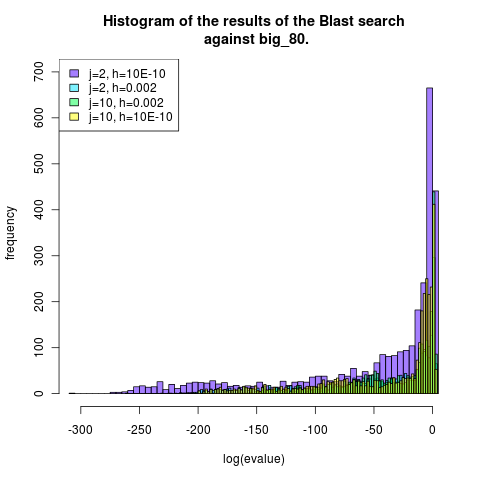
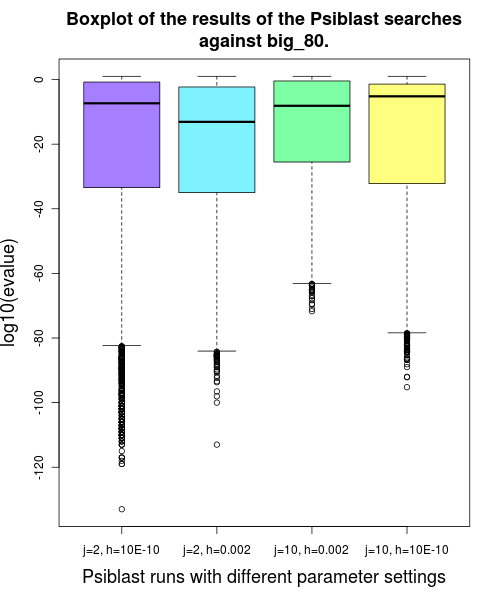
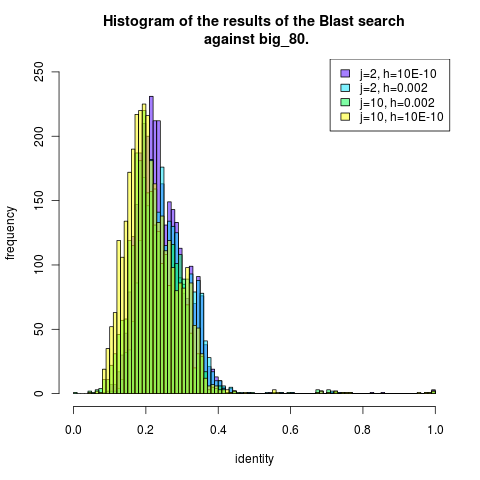
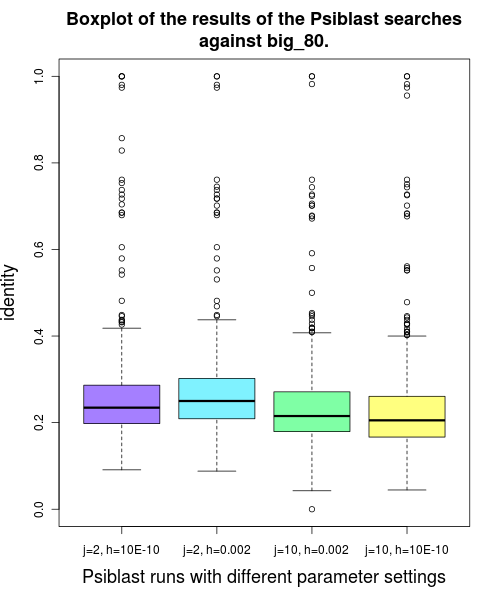
The results of the CATH and COPS classification analysis are listed below:
| psiblast parameters | j=2, h=0.002 | j=2, h=10E-10 | j=10, h=0.002 | j=10, h=10E-10 |
|---|---|---|---|---|
| # hits | 2564 | 3163 | 2601 | 3343 |
| # PDB hits | 66 | 72 | 56 | 66 |
| 0 CATH class | 21 | 21 | 20 | 21 |
| 1 CATH class | 42 | 48 | 33 | 42 |
| 2 CATH classes | 3 | 3 | 3 | 3 |
| same L30 group | 6 | 6 | 6 | 6 |
There are 1095 proteins in the same COPS L30 group as the query HFE. Since the big_80 datatbase does not contain all proteins from pdb, the quality of the program cannot be assesed using the COPS L30 group of HFE. Nevertheless, of the found pdb hits only a few belong to the same L30 and share the same CATH fold classes with HFE.
To get more pdb ids, we also did 4 psiblast searches against /mnt/home/rost/kloppmann/data/blast_db/pdb_seqres using the profiles created with big_80. Those four results were compared as well.
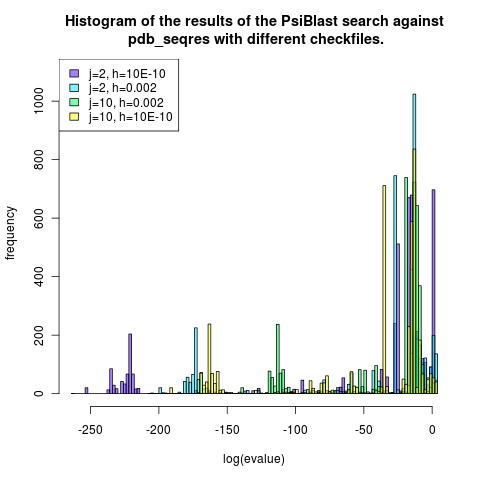
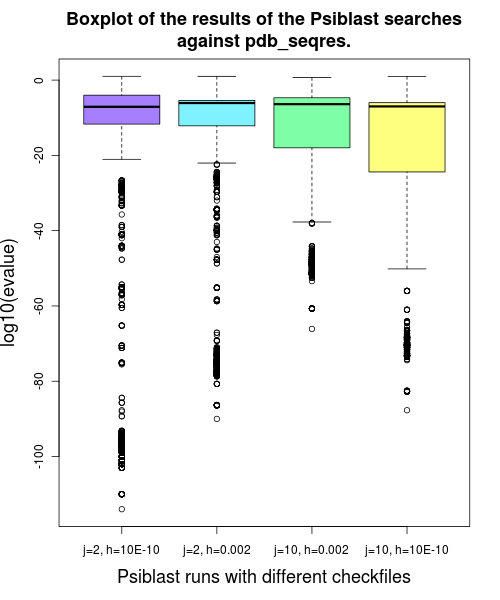
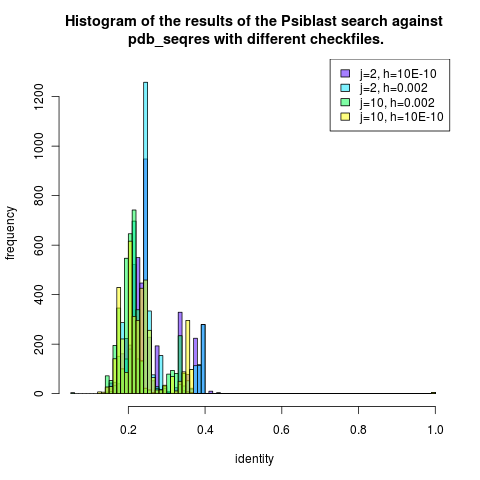
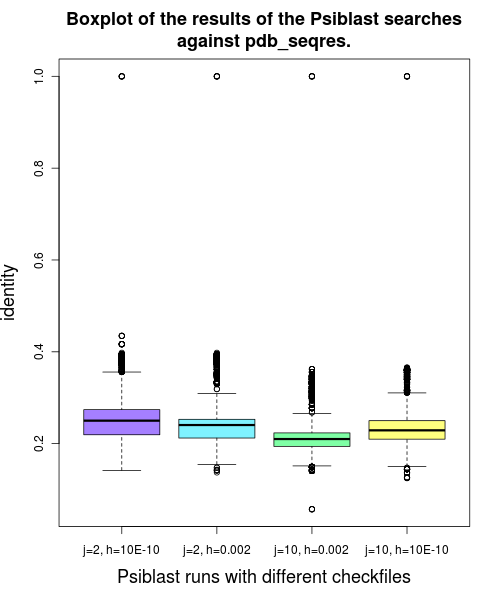
| psiblast checkfiles | j=2, h=0.002 | j=2, h=10E-10 | j=10, h=0.002 | j=10, h=10E-10 |
|---|---|---|---|---|
| # hits | 4307 | 4814 | 3874 | 4058 |
| 0 CATH class | 561 | 586 | 529 | 539 |
| 1 CATH class | 2798 | 3280 | 2397 | 2571 |
| 2 CATH classes | 948 | 948 | 948 | 948 |
| same L30 group | 1047 | 1053 | 1045 | 1052 |
1095 proteins are in the same COPS L30 group as HFE. The differnent psiblast searches found nearly all proteins that are in the same L30 group as HFE. Therefore,the decision which of the parameter settings leads to the best results cannot be based ont he pdb hits, since the differences are minimal.Nevertheless, j=10, h=0.002 had the least hits, but the highest percentage of hits in the same L30 group as the query.
HHblits
hhblits -i /mnt/home/student/betza/data/hfe.fasta -d /mnt/project/rost_db/data/hhblits/uniprot20_02Sep11 -o /mnt/home/student/betza/task2/hhblits/hfe.hhr -oa3m /mnt/home/student/betza/task2/hhblits/hfe.a3m -oalis /mnt/home/student/betza/task2/hhblits/hfe -ohhm /mnt/home/student/betza/task2/hfe.hhm -Z 10000 -B 10000
The output files were analysed using the script parse_output.pl.
example:
perl /mnt/home/student/kalemanovm/master_practical/Assignment2_Alignments/scripts/task1/parse_output.pl --out_p /mnt/home/student/betza/task2/blast/res_blast.txt --query 1a6z_A --sot L30 --out_h /mnt/home/student/betza/task2/hhblits/
It is remarkable that HHblits finds so many hits with a very low evalue. This can maybe explained by the fact, that hhblits found several clusters with a good evalue. Since used all proteins in the clusters for the analyses and not only the cluster representative the number of hits is clearly higher than the number of hits from the Blast and Psiblast searches.
Comparison
TODO: Venn diagramms of hits overlap.
Multiple sequence alignments
The following data sets were chosen for the Multiple Sequence Alignments:
Below 30% SeqID:
| AC Number | Sequence Identity |
| F6JYA9 | 0.29 |
| D9J389 | 0.28 |
| D5MSB3 | 0.27 |
| B3FRK2 | 0.20 |
| 3ov6_A | 0.22 |
| 1p7k_L | 0.21 |
| H0Y1D0 | 0.20 |
| B3FRK3 | 0.18 |
| Q8HWL2 | 0.17 |
Above 60% SeqID:
G5BQE5 0.67| AC Number | Sequence Identity |
| B4DDZ1 | 0.83 |
| Q5EEZ1 | 0.76 |
| G3THV5 | 0.75 |
| G1MBW1 | 0.73 |
| H0VAR7 | 0.72 |
| F1PX48 | 0.71 |
| G1T7D7 | 0.70 |
| O35799 | 0.68 |
Whole range of SeqID:
| AC Number | Sequence Identity |
| B4DDZ1 | 0.83 |
| Q5EEZ1 | 0.76 |
| G1MBW1 | 0.73 |
| H0VAR7 | 0.72 |
| F1PX48 | 0.71 |
| G1T7D7 | 0.70 |
| G5BQE5 | 0.67 |
| Q95IT9 | 0.38 |
| 2qrt-A | 0.38 |
| Q8HX83 | 0.36 |
| F6WCX4 | 0.34 |
| F6JYA9 | 0.29 |
| D9J389 | 0.28 |
| D5MSB3 | 0.27 |
| 2zok_E | 0.24 |
| H0Y1D0 | 0.20 |
| Q8SNJ4 | 0.22 |
| B3FRK3 | 0.18 |
| Q8HWL2 | 0.17 |
pdb:
1p7k_L 0.21
3ov6_A 0.22
2qrt_A 0.38
2zok_E 0.24
ClustalW
Below 30% SeqID: ClustalW_Below_30
Above 60% SeqID: ClustalW_Above_60
Whole range of SeqID: ClustalW_whole
MAFFT
Below 30%:MAFFT_30
Above 60%: MAFFT_60
Whole range: MAFFT_whole
T-Coffee
Below 30%: Tcoffee_30
Above 60%:Tcoffee_60
Whole range: Tcoffee_whole
